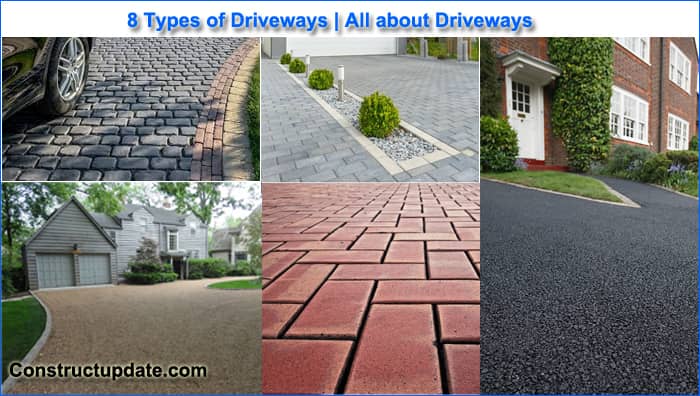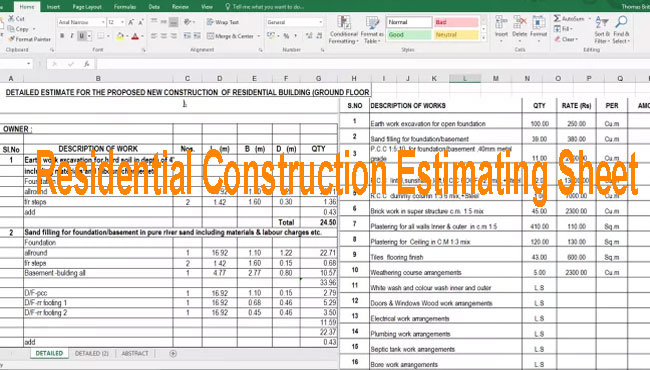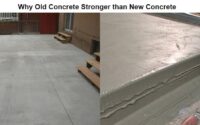What are Driveways | 8 Types of Driveways | All About Driveways
How Do Driveways Work?
A driveway is a type of private road that is owned and maintained by an individual or group and is used for local access to one or a few structures. Although they are unusual, some heavily used driveways—especially those leading to parks and commercial buildings—do have traffic signals. In this article, we will try to understand different types of driveways and their benefits.
1. Concrete Driveways
For various reasons, a famous type of driveway made of concrete is ideal. The main point is that designing it didn’t cost a fortune. Thus, you don’t consider its permanent nature.
Unfortunately, concrete is not flexible like asphalt, so freeze-thaw cycles can crack and seriously damage concrete over time if it is not properly maintained. The use of de-icers containing salt and magnesium chloride makes concrete more prone to spalling.
Local governments also utilise these de-icing products for winter road maintenance. Ice and snow accumulate on the undercarriage of a vehicle as it travels on the roadways. It then affects the concrete surface, leading to spalling, as the automobile pulls into the driveway or garage when it falls from the car and melts, especially if the concrete wasn’t put properly.
Depending on where you live, sub-grade preparation can take anywhere from 1-2 days to up to 2 weeks. After the sub-grade preparation has been completed, an experienced concrete contractor may often construct a new concrete driveway over the course of two to three days, depending on the size and complexity of the work required. You should anticipate the ordinary concrete driveway to take up to 7–10 days to install because the process can be labor-intensive and it must cure for a number of days before you can drive on it and utilise it. For patterned or embossed, stained or overlaid surfaces, much more time can be necessary.

Life Of Concrete Driveways
With periodic care, a properly constructed concrete driveway can last up to 25, 30, or even 35 years! The stability of the sub-grade, the calibre of the installation, the kind and frequency of maintenance, the drainage plan, and the climate of the area you are located in can all affect the age variation.
2. Asphalt Driveways
The most popular alternative is asphalt since it is easy to design, especially when compared to concrete, and this enables a subsequent event to recoup the cost of the design value.
Because asphalt is flexible, it can heave more easily from freeze-thaw cycles than concrete can.
If you happen to live in a snowy area, asphalt is also a great option. More quickly than any other driveway surface, the black hue can absorb the heat from the sun and melt snow.
Installation Time
It takes not long at all to install a brand-new asphalt driveway. Once the sub-grade preparation is finished, installation usually only takes one day. Depending on the soil conditions in your location, sub-grade preparation can take anything from a few hours to a few weeks.
The inconvenience of having one installed is minimal. It can be a little inconvenient, though, if you reside in a place where the sub-grade must settle for a few weeks.
3. Gravel Driveways
Driveways frequently employ gravel, a surface mixture made up of stones, sand, and clay. Gravel, as opposed to simple rocks, stays compact over time to give you a stable surface at all times.
The fact that there are many colour options is another factor in why many people favour this kind of material. Depending on the appearance you desire for the surface of your driveway, you can choose from brown, grey, or even black stones. Unlike to concrete, which only comes in one or two hues and is difficult to alter once installed, this has a variety of colours.
Driveways made of gravel require very little upkeep. The stones last longer, so you won’t need to resurface them as frequently as you would with concrete or asphalt roads. You can anticipate future maintenance cost savings.
Gravel is made up of microscopic stones in comparison to concrete. As a result, they compact more easily over time, giving you a pretty level surface. This also implies that you won’t have to resurface it as frequently, saving you money.
Easily disseminate and install
Gravel is popular among property owners since it is simple to install. Spread the stones out on the driveway area, then use a brush or leaf blower to rake them out until they are evenly distributed across your land. This avoids giving you ugly outcomes while saving you a tonne of time and work.
4. Paver Driveway
For driveways, patios, pool decks, and walks, pavers—slabs or stones that are interlocked or connected—are used to create a flat or level surface. Concrete, natural stones like flagstone or granite, rubber, and brick (clay) are just a few examples of the materials that can be used to make pavers.
For driveway pavers, choose from brick, concrete, stone, or a permeable surface. Every installation of driveway pavers starts with a sturdy base, which is commonly made of compacted gravel and sand.
5. Crushed Stone Driveway
Driveways with crushed gravel are those that have small stones and gritty sand mixed together. The base layer often consists of a combination of sand, dirt, and stone.
The top layer of the driveway can also be constructed with grey gravel, but many people opt for a more aesthetically pleasing material that complements the house, such as marble chips or pea gravel. The middle layer of the driveway is generally composed of plain grey gravel.
6. Cobblestone Driveways
What is Cobblestone?
Cobblestones are small natural stones used for pavement, but the phrase has come to imply a few other things in today’s society. They are typically made of granite, although they can also include other stones or combinations of stones, such as basalt, limestone, or other kinds of natural stones.
Although concrete can be used to make pavers that resemble cobblestones, some paving businesses will refer to their concrete bricks as cobblestones; nevertheless, this terminology is unofficial because concrete is not a natural stone.
In case you’re interested in cobblestone paving, let’s go over some of the advantages and disadvantages of employing cobblestone pavers. This unusual paving material has a wide range of benefits and drawbacks to take into account.
7. Tar and Chip Driveway
What Is a Tar-and-Chip Driveway?
Tar-and-chip pavement resembles asphalt in appearance but is installed differently. The surface is covered and crushed with successive layers of gravel, hot liquid bituminous asphalt, and additional loose stone. You have undoubtedly travelled miles of parking lots and tar-and-chip roads.
You have undoubtedly travelled miles of parking lots and tar-and-chip roads. Also, there is a long history of successful use of this type of paving, particularly in rural regions. It’s also a terrific driveway option for those looking to cut money.
8. Clay Brick Paver Driveway
Brick pavers, often referred to as clay pavers, are produced from clay that is dredged from the seafloor and then heated to create the well-known brick shape. Brick pavers typically have more regular shapes because each brick is the same size and shape. They are best suited for driveway improvements as a result.





